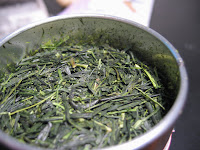
Another Yiwu for the collection.
Picking off leaves for the first brew goes well until I find these odd plastic-like strands:

I don't know what they are. They feel more organic than plastic, like rice-paper. Perhaps scraps from the production of the neifei(inner ticket). I found more of this stuff on the backside of the cake. It will probably be something thats dispersed throughout the life of the beeng.
Plastic pieces out...


On to the brewing...
2006 Yongpinhao Yiwu Zheng Shan
During the rinsing, I find an aroma coming off the wet leaf that I've never smelled before. At first, the smell reminds me in one way or another of hair. As I continue sniffing, I smell something that reminds me of a desert. There's a dry floral quality and a hint of fruit.
1st Infusion

The liquor is very clear. A pale yellow with hints of green. I don't think the leaves fully woke up from the single rinse. The smell is pretty floral, with hints of fruit. The taste is dominated by a fruity flavor. There's no leather or dirt taste to this pu-erh. The main flavor has a lemon-like taste without the citrus. Also in the taste, following the lemon, is a muted wood flavor.
2nd Infusion
The aroma that was coming off the leaf is definitely more pronounced now. It is a strong odor of wood. Like what fills your nose when you walk into a home-improvement warehouse. There's almost a spice to it, like the smell of dry cayenne or cinnamon. The second infusion's color is pretty much the same, but slightly more yellow with some cloudiness. The aroma is muted, but has notes of both wood and dried fruit. The first flavor to hit the tongue in this infusion is the wood. Not dominant over the dried fruit The two flavors are now pretty equal, complimenting each other.
 The tea tastes clean, fresh, mellow, and slightly sweet. I've noticed many Yiwu shengs share these characteristics when they're young. What's particular about this one is the dried-fruit-lemon peel flavor, and the prominent aroma of wood from the wet leaf. In appearance, the wet leaf is mostly green, typical for a young sheng, and some yellow with a couple pale yellow leaves.
The tea tastes clean, fresh, mellow, and slightly sweet. I've noticed many Yiwu shengs share these characteristics when they're young. What's particular about this one is the dried-fruit-lemon peel flavor, and the prominent aroma of wood from the wet leaf. In appearance, the wet leaf is mostly green, typical for a young sheng, and some yellow with a couple pale yellow leaves.3rd Infusion
The aroma seems to stick to the leaves, as the brewed tea carries only muted notes of wood, but the wet leaf still throws out a strong wood aroma. The tea this time carries a little less flavor. The lemon taste now comes out just on top of the wood and is followed by a smooth, sweet finish.
4th Infusion
Gave it a little more time, about 30 seconds. Came out better. A slight hint of astringency accompanying the wood at high temperature. As the tea cools, the flavors are brought back into balance to give a smooth and mellow cup. Wood being complimented by dry lemon peel.
5th Infusion

The color is on the verge of decreasing, the flavor is in balance, but has decreased. I figure this is the last developing steep, but I will probably get two more good ones out.
Overall Impressions: 2006 Yongpinhao Yiwu Zheng Shan
I think this tea is well done. As with most of the Yiwu I have, this pu-erh is young, but already pleasant and drinkable. The wet leaf of this one lets off a very dominant and persistent aroma of fresh and cleanly cut wood. Like that of a home-improvement store. The flavor was composed of wood and lemon-peel(without any citrus bite). The two flavors complimented each other, but one of them was usually more prominent in the taste.
It will be interesting to see what the lemon and wood aromas develop into over time. Although this one is nice young, it's going into the aging section for the time being. When I'm in the mood for pu-erh, 2006's are usually just a tad too young. Being young, they are a bit similar to green tea, and when I want green tea, I'm pulling out the kyuusu.






















